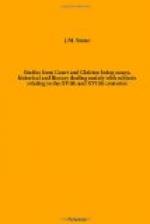An undated manuscript, preserved at Oxburgh, containing a plan of an itinerary for the queen’s progress into Norfolk, would seem to support the tradition that Elizabeth visited that place. Perhaps she intended to visit it, for immediately after Walsingham, which then belonged to the Sidneys, occurs the sentence: “Thence to Oxburgh, Sir Henry Bedingfelds."* This document is printed in Blomefield’s History of Norfolk, and the date assigned to it is 1578, presumably because this was the only time at which Elizabeth visited Norfolk. There are, however, no details of any visit to Oxburgh, and Dr. Jessopp, considering that the place was quite out of the line of progress, is of the opinion that she never went there at all.**
* The so-called Queen’s room, a large apartment above that in which Henry vii. undoubtedly slept may, it appears to the present writer, have been occupied by Elizabeth of York, wife of Henry vii., who, it is well known, accompanied him on, at least, one pilgrimage to Walsingham. As she also was Queen Elizabeth, this may account for the tradition,
** One Generation of a Norfolk House, p. 61.
But there are other and more weighty reasons than those of distance for arriving at this conclusion. From the year 1569, when the foremost English Catholics attempted to liberate Mary Queen of Scots, the penal laws against Papists were redoubled in severity, and those who still clung to the old religion fell into disfavour. Elizabeth did indeed visit Euston Hall, near Thetford, in 1578, and Mr. Rookwood presumed to kiss her hand. But the Lord Chamberlain severely reprimanded him for so doing, sternly bade him stand aside, and charged him with being a recusant, unfit to be in the presence, much less to touch the sacred person, of his sovereign. He was required to attend the Council, under surveillance, and when he reached Norwich, in the queen’s train, was committed to jail.
Many other recusants were treated in 1578 as Rookwood was. Two of the Lovells, Humphrey Bedingfeld of Quidenham, Sir Henry’s brother, one Parry, and two others, “not worth memory for badness of belyffe,” were confined in Norwich Castle” for obstinate papystrie."*
* Mason, History of Norfolk, p. 150.
“At Norwich, the Queen lodged at the bishop’s palace, and spent her time, as far as the bad weather would allow, in listening to absurd speeches and witnessing grotesque pageants, but on the 19th August, she suddenly resolved to go a-hunting in the park of Cossey, five miles from Norwich, which belonged to Mr. Henry Jerningham, ancestor of the present Lord Stafford. Once more her host was a recusant, but this time it would have been too shameless to proceed against him. Mr. Jerningham had made himself very conspicuous in opposing the abominable attempts to set aside Mary and Elizabeth as heirs to the Crown at the death of Edward vi., and in return for his loyalty, had received this very




